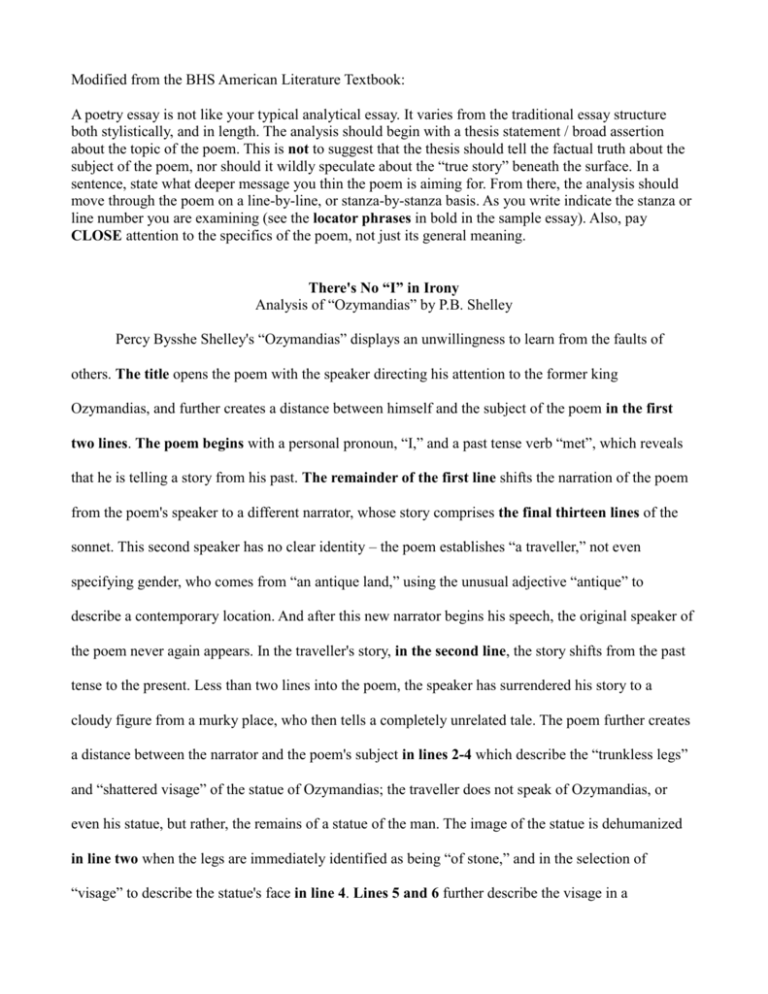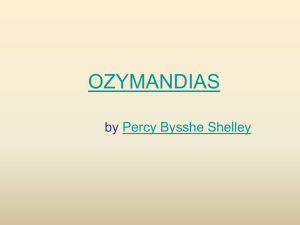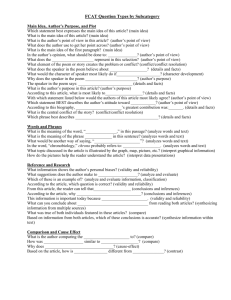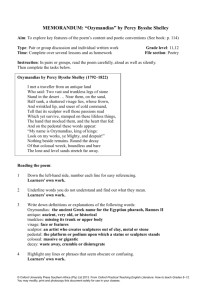Sample Poetry Essay
advertisement

Modified from the BHS American Literature Textbook: A poetry essay is not like your typical analytical essay. It varies from the traditional essay structure both stylistically, and in length. The analysis should begin with a thesis statement / broad assertion about the topic of the poem. This is not to suggest that the thesis should tell the factual truth about the subject of the poem, nor should it wildly speculate about the “true story” beneath the surface. In a sentence, state what deeper message you thin the poem is aiming for. From there, the analysis should move through the poem on a line-by-line, or stanza-by-stanza basis. As you write indicate the stanza or line number you are examining (see the locator phrases in bold in the sample essay). Also, pay CLOSE attention to the specifics of the poem, not just its general meaning. There's No “I” in Irony Analysis of “Ozymandias” by P.B. Shelley Percy Bysshe Shelley's “Ozymandias” displays an unwillingness to learn from the faults of others. The title opens the poem with the speaker directing his attention to the former king Ozymandias, and further creates a distance between himself and the subject of the poem in the first two lines. The poem begins with a personal pronoun, “I,” and a past tense verb “met”, which reveals that he is telling a story from his past. The remainder of the first line shifts the narration of the poem from the poem's speaker to a different narrator, whose story comprises the final thirteen lines of the sonnet. This second speaker has no clear identity – the poem establishes “a traveller,” not even specifying gender, who comes from “an antique land,” using the unusual adjective “antique” to describe a contemporary location. And after this new narrator begins his speech, the original speaker of the poem never again appears. In the traveller's story, in the second line, the story shifts from the past tense to the present. Less than two lines into the poem, the speaker has surrendered his story to a cloudy figure from a murky place, who then tells a completely unrelated tale. The poem further creates a distance between the narrator and the poem's subject in lines 2-4 which describe the “trunkless legs” and “shattered visage” of the statue of Ozymandias; the traveller does not speak of Ozymandias, or even his statue, but rather, the remains of a statue of the man. The image of the statue is dehumanized in line two when the legs are immediately identified as being “of stone,” and in the selection of “visage” to describe the statue's face in line 4. Lines 5 and 6 further describe the visage in a mechanical way, with two of the three descriptions (“frown,” and “sneer of cold command”) point to the face's expression rather than to the face itself. Ozymandias the king is reduced to a “wrinkled lip” and a series of external descriptions. The poem is not entirely successful in dehumanizing the statue's subject, or in removing the speaker from the poem however. Shelley uses the active verbs “stand” and “tell” to describe the statue's legs and lips, reasserting Ozymandias's humanness. The poem's title is immediately followed in the first line by the lone personal pronoun that refers to the speaker of the poem, thus binding the two subjects together. The similar assonance and internal rhyming of the two speakers' opening sentences – “traveller,” “antique land,” “vast,” “Stand,” and “sand” connect their stories, and suggest that the speaker cannot fully vanish from this tale. Line six further humanizes the statue, as it indicates that the sculptor of the statue could understand Ozymandias's emotions, which “yet survive” after centuries, despite being surrounded by “lifeless things”. Immediately after this statue begins to project emotion, the traveller meditates on “the hand that mocked them, and the heart that fed,” envisioning Ozymandias as he once lived and ruled (8). In the opening octet of the poem, the narration shifts from cool detachment to compassion and anger, which leads to the volta of the sonnet. Line 9 directs the poem's attention to the pedestal of the statue, the lone piece of the statue mentioned in the entire poem that is not in fact a part of Ozymandias. Yet, the traveller then recites the engraving on the statue, which are the words of Ozymandias himself. The words “appear” on the statue, suggesting an almost magical quality to what is about to be spoken, and in lines 10 & 11, Ozymandias himself becomes the speaker of the poem, stating “My name is Ozymandias, King of Kings / Look on my Works ye Mighty, and despair!” In this moment, the narration becomes further removed from the original speaker; an “antique” traveller tells the words that he once read on the base of a far-distant and ancient statue that commemorates a man who is long dead. Yet, the poem again links the speaker to the subject. Ozymandias's inscription, like the speaker, begins with a first-person pronoun, and the brevity of both speakers stand out in contrast to the long-winded speech of the traveller, whose narration from line 2 to 9 is one circuitous sentence. Both the speaker and Ozymandias get to the point, with the speaker starting with “I met...” and Ozymandias saying “My name is...” while the traveller is more loquacious.








